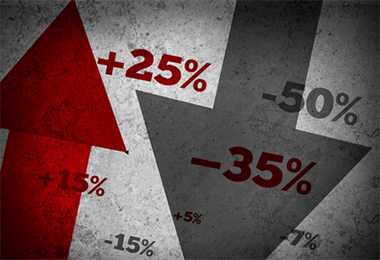This is an election year, and recent news headlines suggest there’s plenty of investor concern about what the presidential election in the U.S. this upcoming autumn will mean for market volatility.
Consider some of the stories making the rounds:
The question everyone wants to know is, have U.S. election events influenced sector dispersion or volatility expectations in election years? Let’s look at a few examples.
Greater Sector Dispersion In November 2016
The four largest sector ETFs are the Technology Select Sector SPDR Fund (XLK), with $28 billion in total assets; the Financial Select Sector SPDR Fund (XLF), with $25 billion; the Health Care Select Sector SPDR Fund (XLV), with $20 billion; and the Consumer Discretionary Select Sector SPDR Fund (XLY), with $15.5 billion.
As shown in the chart below, dispersion among Select Sectors increased significantly after the Nov. 8, 2016 U.S. election. Sectors that had big gains that month included financials (up 14%), industrials (up 9%) and energy (up 9%), while there were losses for four sectors, including consumer staples (down 4%) and utilities (down 5%).
This raises the issue that if in November 2020, there is another big, unexpected change in the U.S. election outcome, what type of dispersion will we see among the sectors? (You can track sector and options on sectors here.)

For a larger view, please click on the image above.
Luckily for investors who wish to manage their portfolio risk and track measures of volatility expectations throughout the 2020 election year, there are risk management tools and gauges for term structure and future implied volatility.
VIX Futures Prices, Term Structure & Investor Sentiment For Future Months
The recent VIX futures term structure chart below shows that, on Jan. 30, the VIX futures expiring on Oct. 21 were priced at 19.92, a price that was 12% higher than the September futures. The October VIX futures reflected expectations of 30-day forward volatility on Oct. 21, and thus the futures reflected expected volatility around the upcoming Nov. 3 U.S. election.

For a larger view, please click on the image above.
Here’s what the VIX Futures term structure tells us and how it can help inform your investing decision:
- Meaning: VIX futures prices reflect the market’s expectation of 30-day forward volatility on the expiration date, and the term structure chart shows the prices for VIX futures with various expiration dates in the future.
- Range: Prices in this chart range from 15.49 for the VIX Index to 19.7 (27% higher) for VIX futures expiring on Oct. 21.
- Election Volatility: The fact that the 19.7 price for the October futures was at least 12% higher than futures with earlier expirations shows that the market’s concern about higher volatility was greatest for the period from Oct. 21 to Nov. 20 (around the Nov. 3 U.S. election).
- Open Interest for the Oct. 21 VIX futures was 6,772 contracts (76% higher than the September open interest, and a higher-than-average amount for 9-month VIX futures)
- Key U.S. Election Dates: Iowa caucuses on Feb. 3, Super Tuesday primaries on March 3, and the U.S. election on Nov. 3.
- Protective Strategies: For investors concerned about a possible rise in volatility and fall in equity prices in a future month, protective strategies that could be considered include long VIX futures, long VIX call options and long SPX put options.
- Calendar Spreads: Some expert traders engage in VIX futures calendar spreads, with the buying of a VIX futures contract maturing in one month and selling another contract maturing in a different month.
Recent Shifts In 5 Volatility Indexes From VIX9D To VIX1Y
For investors who wish to track the intraday or long-term values for expectations of future volatility and the term structure for S&P 500 (SPX) options, these five indexes provide useful information:
- Cboe S&P 500 9-Day Volatility Index (VIX9D)
- Cboe Volatility Index (VIX) (30-day)
- Cboe S&P 500 3-Month Volatility Index (VIX3M)
- Cboe S&P 500 6-Month Volatility Index (VIX6M)
- Cboe 1-Year Volatility Index (VIX1Y)
All five indexes provide market estimates of expected (implied) volatility that is calculated by using real-time S&P 500 Index option bid/ask quotes.
As shown in the chart below, on Jan. 27, the VIX9D Index (which is a real-time gauge of expectations of nine-day volatility) had the highest value of the five indexes, and that the Iowa caucuses for the 2020 U.S. election are scheduled for Feb. 3 (seven days after Jan. 27).

For a larger view, please click on the image above.
Disclaimer: ETF.com is a Cboe subsidiary.
Options involve risk and are not suitable for all investors. Prior to buying or selling an option, a person must receive a copy of Characteristics and Risks of Standardized Options (ODD). Copies of the ODD are available from your broker or from The Options Clearing Corporation, 125 S. Franklin Street, Suite 1200, Chicago, IL 60606. The information in this article is provided solely for general education and information purposes and therefore should not be considered complete, precise or current. Many of the matters discussed are subject to detailed rules, regulations and statutory provisions that should be referred to for additional detail, and are subject to changes that may not be reflected in the website information. No statement within the website should be construed as a recommendation to buy or sell a security or to provide investment advice. Past performance is not predictive of future returns. Cboe® and VIX® are registered trademarks of, and many other indexes are servicemarks of, Cboe Options Exchange (Cboe). S&P® and S&P 500® are registered trademarks of Standard & Poor’s Financial Services, LLC, and are licensed for use by Cboe. ©2020 Cboe Exchange, Inc. All rights reserved.

